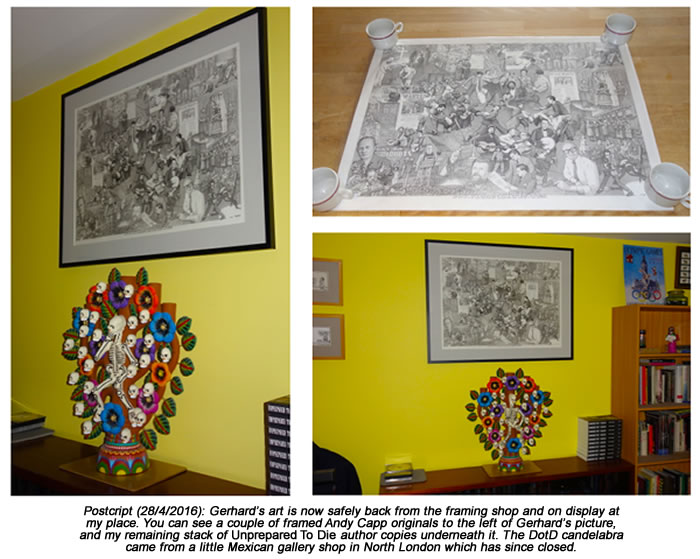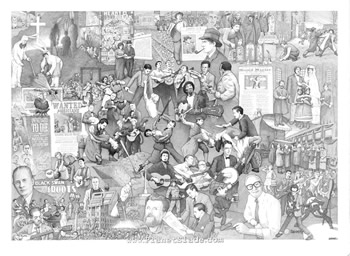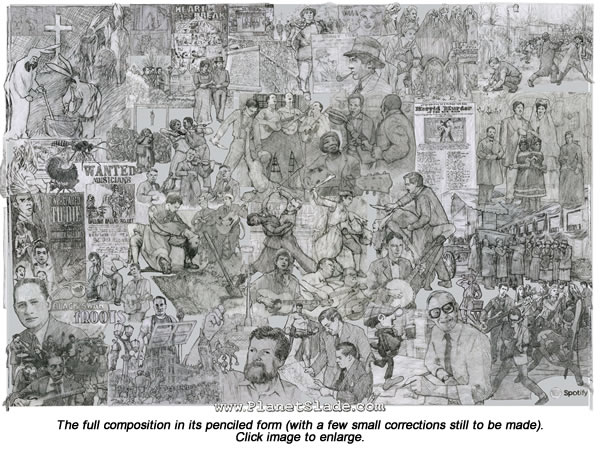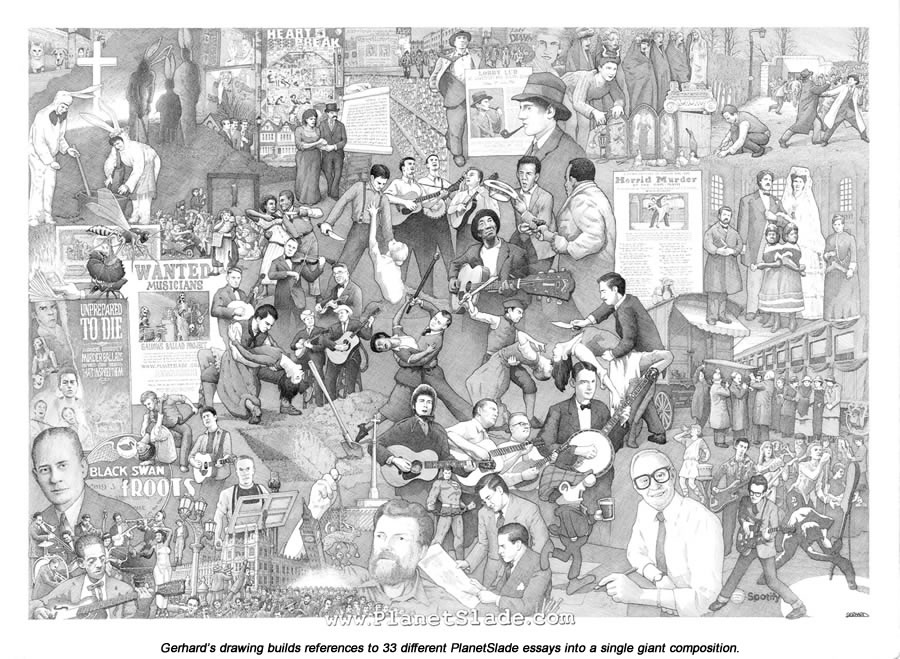
Back
at the beginning of 2014, it struck me that PlanetSlade's fifth birthday was looming, and that it might be fun to commission a piece of artwork commemorating this milestone. I knew from the Rick Geary and Hans Rickheit art I'd commissioned in the past that this could be a surprisingly affordable thing to do, and one which opened the door to working with some remarkably talented people.
The piece itself, I decided, should include representations of all PlanetSlade's 30 essays to date, preferably integrated into a single, composite drawing. The model I had in mind was something like the Jamie Hernandez poster for Bob Dylan's Theme Time Radio Hour, which combines all the noirish characters and events from that show's spoken-word introduction into a single cityscape. "It's night-time in the big city," the narration begins. "A night shift nurse smokes the last cigarette in her pack. The moon goes behind a cloud. A truck drops off tomorrow's newspapers. A Styrofoam coffee cup rolls across the street. Two sailors get out of a cab."
And so it goes on: every one of the introduction's 40+ vignettes is shown somewhere in the Hernandez poster, and I thought a similar "collage" approach might work well for PlanetSlade. Me being me, though, the site's fifth birthday in June 2014 came and went with this idea never getting beyond the good intentions stage. Finally, in November last year, I got round to doing something about it.
I knew the Canadian artist Gerhard's work from his time on Dave Sim's monthly comic book Cerebus, which he joined in August 1984 and remained an indispensible part of for the next 20 years. He's normally described as the book's background artist, but that title really doesn't do him justice. Although Cerebus remained entirely guided by Sim's vision, with Sim himself continuing to write every issue and draw all its characters, it was Gerhard's impeccable draughtsmanship and design sense which gave those characters such an utterly convincing world to live in. Every building and room he drew had a real heft to it, a consistent geography and a textured finish which made you want to place a hand against the cold of its stone walls.
In movie terminology, Sim's role on the book could be described as writer, director and producer, while Gerhard's job combined set designer, chief lighting engineer and cinematographer. Working alongside Sim on an unbroken monthly deadline for its final 236 issues, he produced a stunning run of work there. When Cerebus reached completion in March 2004, Gerhard had begun accepting outside commissions, and I knew he'd be perfect for the project I had in mind.
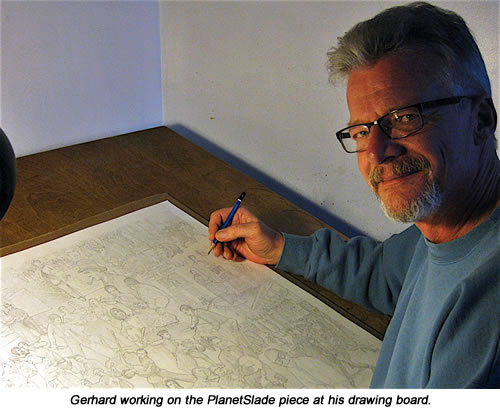 By that time, PlanetSlade's essay count had swollen to 33, so I also knew that an awful lot of work would be involved - perhaps so much that no artist would want to take it on for the money I had available. It couldn't hurt to ask, though, so I dropped Gerhard a line at his website explaining what I had in mind and asking him to quote me a price.
By that time, PlanetSlade's essay count had swollen to 33, so I also knew that an awful lot of work would be involved - perhaps so much that no artist would want to take it on for the money I had available. It couldn't hurt to ask, though, so I dropped Gerhard a line at his website explaining what I had in mind and asking him to quote me a price.
"I've been mulling over which artist to contact about this for some time," I wrote. "The thing that made me plump for you was the gorgeous cover you provided for that large-format Little Nemo volume recently. What I'd like to do is get some idea how many days you'd need to devote to the PlanetSlade art to do an equally beautiful job on that.
"My only stipulations are that the art be landscape in orientation and that the PlanetSlade logo appears prominently somewhere on the piece. Everything else I'd be happy to leave up to you. We're talking about 33 individual images built into one overall composition, and I do realise that's a LOT of work [but] I hope this is something you might be interested in doing."
Gerhard was pretty busy at that point, but he found time to do a spot of homework on PlanetSlade to see what he'd be letting himself in for and to start thinking about how much he'd need to charge me for a commission of this scope. As one of the e-mails we were firing back and forth, I gave him a definitive list of the 33 essays to be covered, indicating which I thought should be given most space in the final composition and which could be shrunk to postage-stamp size. Armed with that, I hoped, he might be able to begin making sense of it all.
By the end of January, we'd agreed a price and all the other details, so Gerhard began work in earnest. "Having gone through your website (quite the trip!) and done my own gathering of related images, I set about doing a sketch for each subject and then fitted them together jigsaw-puzzle-like into one giant collage," he told me on February 19.
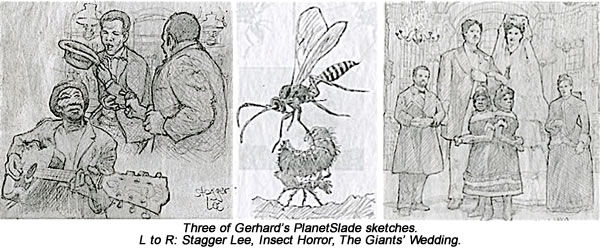
"One of the things I came up with early on was to have the murder ballad sung/played by a musician, and the scene acted out by the characters in a dance pose... sort of a 'Murder Ballet' (except for 'Stagger Lee' which is based on the Ruby/Oswald shooting). Anyway... I had a lot of fun with it and I hope you like the idea and the layout."
I loved the Murder Ballet idea, which struck me as being a very ingenious way to combine the twin aspects of those particular stories. I also liked the fact that he'd included enough detail for each couple to be clearly identified. In the case of Hattie Carroll, for example, there's Zantzinger's cane to mark them out, as well as the young Bob Dylan immediately below. For Pretty Polly, we have not only The Stanley Brothers immediately next to the dancers, but also that ballad's "newly-dug grave with a spade standing by".
I sent Gerhard a note congratulating him on this idea. "I'm so glad that you are able to tell which scene is which," he replied. "I was wondering if you were going to want little labels saying Knoxville Girl etc. and hoping that you wouldn't. I tried to use images of musicians that did early versions of the songs. Or just the picture I like the best."
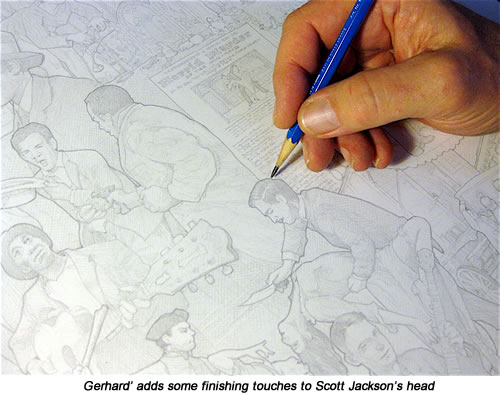 Concentrating on the early musicians struck me as good idea as well, because they conveyed much more of a sense of what Greil Marcus called "the old, weird America" - and I'm always a sucker for that. I knew that Gerhard sometimes drew his own version of Cerebus for fans (a character he called Gerebus in deference to the fact that Sim had always drawn him in the book), so I asked him to sneak a teeny-tiny one of those into the composition too. See if you can find it above.
Concentrating on the early musicians struck me as good idea as well, because they conveyed much more of a sense of what Greil Marcus called "the old, weird America" - and I'm always a sucker for that. I knew that Gerhard sometimes drew his own version of Cerebus for fans (a character he called Gerebus in deference to the fact that Sim had always drawn him in the book), so I asked him to sneak a teeny-tiny one of those into the composition too. See if you can find it above.
I came back to Gerhard's pencils again and again over the next couple of days, relishing all the tiny details he'd packed into the composition: details like the apt location chosen for his Treasure Hunt Riots scene; a glimpse of Ronnie van Zant at the back of the Moshpit Memories crowd; and the Murder Ballet motif applied to an 1837 ballad sheet. For someone with my love of comics and cartooning, there were other treats too. Who'd have thought we'd ever see a Gerhard drawing of Reg Smythe's Andy Capp? Or of Peattie and Tayor's Alex Masterley?
I did find one or two small problems as I continued to study the drawing, but nothing that couldn't be easily fixed. There was a typo in the Gallows Ballads Project's poster, for example, and the wrong murder weapon shown in Nasra Ismail's section. We went back and forth on the placement of the PlanetSlade logo for a while, but eventually settled on a slot at the bottom of the picture. Gerhard sent me a second version of the pencils with all these changes in place, which looked like this:
On March 8, he started posting progress reports about this piece on his own blog, showing his research photographs, sketches and work to piece all the elements together in a coherent way. "Good luck with not going insane while inking this colossus," one of his readers remarked.
It was only when Gerhard sent me a third scan next day, this one showing his final pencils, that I spotted he'd accidentally labeled Reverend Knox's radio microphone as 'CBC" rather than "BBC". As a proud Canadian, his subconscious had evidently taken control and substituted the Canadian Broadcasting Corporation for our own dear Auntie Beeb. "That is too weird," Gerhard replied when I pointed this out. "I specifically meant to write BBC and would have sworn that I had."
Gerhard's appearance at the Toronto Comics Convention interrupted proceedings for a few days in March, but by the end of that month he'd completed inking my piece. "With any luck, I'll be able to get it scanned properly tomorrow," he told me on March 31. "I'm going to have a beer (or two) now." I'd just enjoyed a couple of pints myself when that e-mail arrived, so it seemed we were both on the same page.
Two days later, I had Gerhard's HD scan of the finished work. "The central murder ballads were designed to stand out more," he explained. "I used more contrast and heavier lines. I wanted to keep the edges [of the page] softer and lighter. I thought it gave the piece more focus, since it's such a chaotic jumble of images."
And that, I think, is the whole story. As I write this on April 9, Gerhard's payment for the job is safely in his bank account, his original art's completed its journey from Ontario to my London home, and I've got a spot picked out for it just above the Day of the Dead candelabra in my spare bedroom. Even though I missed that fifth birthday by a country mile, I'll have it properly framed up and hung there long before PlanetSlade turns seven this June. Better late than never, eh?
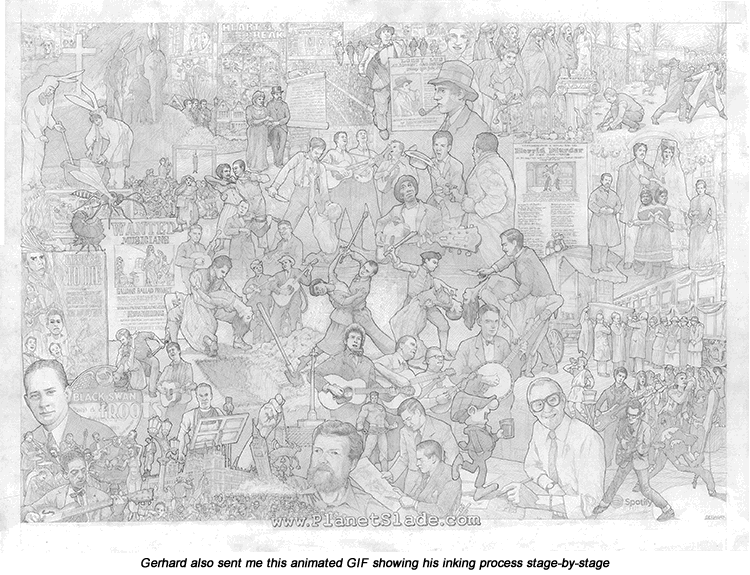
Many thanks to Gerhard for all his work on this piece. You can read his own account of completing it in his March and April 2016 blog posts here, where you'll also find some of his sketches and research photographs, plus one or two of the earlier ideas he decided to reject. There's lots more Gerhard art to enjoy on the same site, including a commission he recently completed for TV hospital drama The Knick and a licensed Harry Potter poster for Dark Hall Mansion. A Moment of Cerebus has more Gerhard news here.
